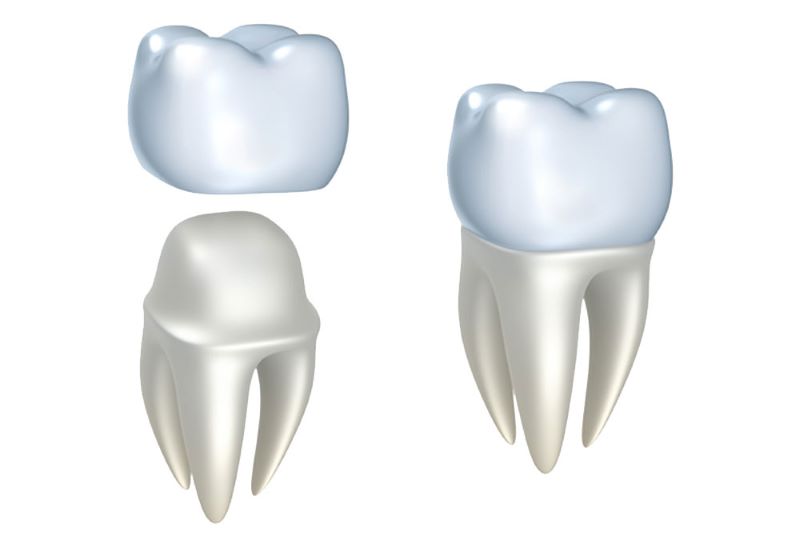The Benefits of Dental Crowns

The American Dental Association defines a crown as an artificial replacement that restores missing tooth structure by surrounding the remaining coronal tooth structure, or is placed on a dental implant. It is made of metal, ceramic or polymer materials or a combination of such materials. It is retained by luting cement or mechanical means.
In simpler terms, a crown, sometimes referred to as a “cap”, is a prosthetic tooth that is used to restore teeth where the structure is too weakened or damaged to have amalgam or dental composite fillings. A crown can help strengthen a tooth with a large filling when there isn’t enough tooth remaining to hold the filling. Crowns can also be used to attach bridges, protect a weak tooth from breaking or restore one that’s already broken, and they are a great way to cover teeth that are discolored or badly shaped. (American Dental Association)
Dental technology has come a long way to improve the look of crowns. Compared to the old-style bridges, these works of art are exceptionally well fitting and very natural looking. Using a bridge or crown with metal base covered with porcelain or using all porcelain material eliminates the dark edges at the gum line that have been visible with the old style of bridges and crowns.
Dental Crown vs. Dental Bridge
As defined by the American Dental Association, a bridge, which is sometimes called a fixed partial denture, replaces missing teeth with artificial teeth and literally “bridges” the gap where one or more teeth used to be. It is not uncommon for patients to mistake a bridge for a crown, and vice versa. Though the procedures for crowns and bridges are almost identical, the main difference between the two is really what their purpose is. A crown covers a damaged tooth without extracting the tooth, whereas a bridge is used to completely replace a missing tooth (or multiple, bridges can replace up to three missing teeth in a row) and anchors to existing teeth in the surrounding area.
Types of Dental Crowns
Crowns can be made out of various types of materials such as metal, porcelain, ceramic, composite resin, zirconia, or even a combination of metals. Your dentist is the one who determines which material should be used for your crown based on a multitude of factors including the location of your tooth, the color of your surrounding natural teeth, and the type of functionality the tooth receiving the crown needs. At Willow Springs Dental, we choose to use metal free restorations. Aside from the various types of materials that can be used for a crown, there are also different types of crowns; temporary crowns, one day crowns, permanent crowns, and ¾ crowns (onlays). The most common types of crowns are permanent crowns and temporary crowns.
Permanent Crowns: Permanent crowns are the most common type of dental crown. Because they are permanent, they typically use better and stronger materials than crowns that are temporary. Permanent crowns typically last anywhere from five to fifteen years.
Temporary Crowns: Temporary crowns are only made of plastic and metal. These cheap and lower quality materials are used due to the nature of temporary crowns and that they are only needed for a few weeks as a short term solution while you await your permanent crown. The temporary crown is placed over your tooth with an easily removable adhesive.
A Simple Procedure
The procedure for a dental crown can take place during either one or two appointments, depending on whether your dentist opts for a multi-day procedure or a same day procedure, called CEREC Crowns. Both same day and multi day procedures are quite easy and just another benefit to dental crowns!
With a multi-day procedure, you will need to visit your dentist for two different appointments. The prep for this procedure may include x-rays or molds of your teeth and mouth. The outer layer of your tooth will be filed down, and an impression will be taken and sent to the lab for your permanent crown to be made. At this first appointment, a temporary crown will be placed over your tooth to protect it until the next appointment. The second appointment is where your permanent crown will be cemented to your tooth.
For a same day procedure, you will not receive a temporary crown. Instead, your dentist will take digital pictures of your mouth, and these images are how the dentist creates the crown. This is often called a CEREC Crown, or Chairside Economical Restoration of Esthetic Ceramics. After one to two hours, the crown will be ready and is cemented in place. The entirety of the process should only take between three and four hours!
The Benefits of Our Same Day CEREC Crowns
Cerec is a proven technology with two decades of clinical research and documentation. Using a CADCAM-3 imaging system, CEREC crowns and onlays can be custom made in about an hour right here at our Willow Springs Dental facility. This state-of-the-art technology produces high quality, tooth colored all ceramic restorations ready to place during the same appointment- no lab needed.
CEREC crowns have several other advantages compared with the standard dental crown process. These benefits include:
- More natural look
- No need for impressions
- No need for a temporary crown
- No possibility of human error in crown fabrication
- Last longer than conventional crowns, up to 30 years
Materials used to make dental crowns include metal alloys, composite resin, and a combination of porcelain and metal. However, same-day CEREC crowns consist of a solid, single block of ceramic. This means they’re almost as strong as dental enamel. They look and feel like a real tooth and avoid the darkened edges of crowns with a metal foundation.
Top Benefits of Dental Crowns
- Strengthen your teeth
- Protect your weak teeth from breaking
- Treat a discolored tooth or discolored implant
- Improve appearance of your smile
- Come in a variety of materials to match your natural teeth
- Strong and durable, lasting between 5 to 30 years
If you think you may be a good candidate for a dental crown, reach out to us at Willow Springs Dental, your Summerlin dentist, to schedule a consultation today!




Please login to publish a comment.
Comments (1)